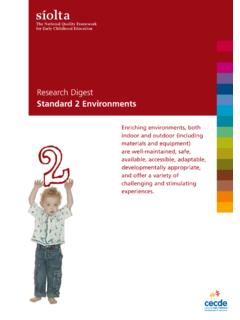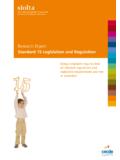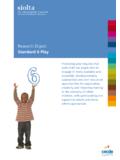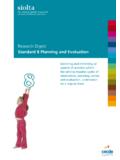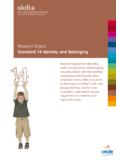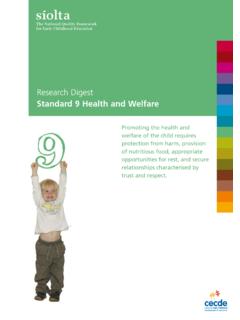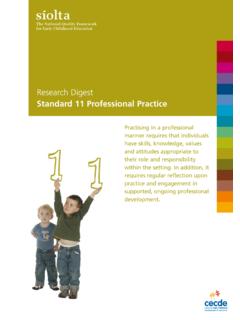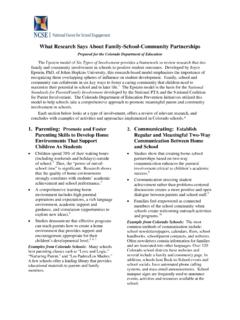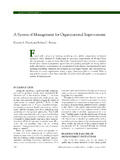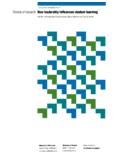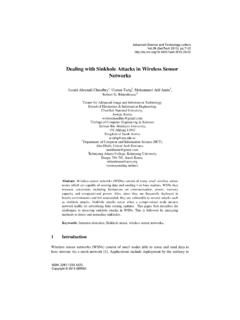Transcription of Research Digest - siolta.ie
1 S olta The National Quality Framework for Early Childhood Education Research Digest Standard 13 Transitions Ensuring continuity of experiences for children requires policies, procedures and practice that promote sensitive management of transitions, consistency in key relationships, liaison within and between settings, the keeping and transfer of relevant information (with parental consent), and the close involvement of parents and, where appropriate, relevant professionals. Introduction Young children may experience many transitions in their lives;. from home to an early childhood setting, between early childhood settings, from there to primary school and from one aspect of the daily routine to the next. The early years mark the beginning of these various transitions and so, early childhood care and education (ECCE) settings have a tremendous role in laying strong foundations for ensuring the continuity of experiences for young children.
2 In order to support these transitions, and to make them meaningful to everyone involved, effective management and a variety of communication systems ( Research Digest /Standard 12: Communication) are required. This involves developing policies, procedures and practice that promote consistency in key relationships, liaison within and between settings, the keeping and transfer of relevant information (with parental consent) and the close involvement of parents and relevant professionals. Socio-cultural factors are paramount to any understanding of transitions. The child and her/his surrounding environment are not separate entities. Rather, the child is part of a social matrix where previous experiences influence the speed and comfort at which she/he can make the transition from one setting to another.
3 Personal, family and background experiences, for example, impact on a child's adjustment to a new setting. When making a transition, the child is leaving behind (albeit temporarily). someplace where they have an established sense of identity, and beginning someplace where they will engage in new experiences, face physical, social, and behavioural changes, and meet with new challenges and expectations. This raises issues of continuity and discontinuity. It is, therefore, imperative that transitions are facilitated in a sensitive, responsive and smooth manner. Research Research Digest Digest s olta s olta Transitions Transitions . Recent Research Consistent key relationships Transitions are eased by the child's experience, from birth onwards, of reliable, stable, continuous, and loving relationships.
4 Close and direct contact by the primary caregiver with the settings, along with careful thought applied to the transitions children experience in their care, is required (Keinig, 2002). This can be facilitated in early childhood settings through a key worker system, where each child and family is assigned a person who has a particular responsibility for liaison with the child and family, and who may: Undertake a home visit in advance of a child coming to the centre Assess, understand and plan to meet the child and parent's/. carer's needs Link closely with parents/carers in helping to settle the child into the centre Understand cultural differences and/or key words from a child's first language Make contact at the beginning and end of each day with the child and parent/carer Ensure that transitions within the daily routine are sensitively planned ( , children are alerted to the next activity, have choice regarding who to sit beside, are given sufficient time to finish their previous activity).
5 Monitor the curriculum offered to the children for depth, Research Digest s olta Transitions balance, and relevance ( Research Digest /Standard 7: Curriculum). Provide an update on progress and advice to other team members, and take part in reviews with the children Support the child in the transition to school Bridge the worlds of home and the setting (French, 2003;. French and Murphy, 2005).. The provision of reminders of home, such as special toys, blankets and soothers, and photographs of special people and pets, can also support the transition from home to the setting (French and Murphy, 2005). Dockett and Perry (2002) identified two elements of school readiness Research that have been ignored first, the significance of children's ability to form meaningful relationships and, second, understanding issues from the child's perspective.
6 Cassidy (2005) concurs; children are rarely, if ever, consulted on their experience of the transition to school. For them, knowing the rules and having friends when starting school are the most significant factors (Dockett and Perry, 2002). Smooth transitions are supported by consultation and communication between settings (home, early childhood service, school and specialist staff), sharing information and establishing welcoming environments for the child and family (Fabian and Dunlop, 2002). Appropriate liaison and consultation within and between settings Research has highlighted the significance of smooth transitions between settings and the long-term impact of how these transitions are experienced (Dockett and Perry, 2002; Fabian and Dunlop, 2002; Keinig, 2002; Cassidy, 2005; O'Kane and Hayes, 2006).
7 Success in earlier transitions can positively influence subsequent ones. Conceptualised as border crossing', children need support to mark and successfully negotiate transitions (Keinig, 2002; Fabian and Dunlop, 2005). In order for children to feel suitable' ( , having feelings of well-being, identity, belonging and capability to succeed), Brostrom (2002) explores the requirement for children being ready for school, and also for schools being ready for children. She enumerates several practical activities that are considered Research Digest s olta Transitions to be positive in supporting transitions, including positive liaison (based on personal contact prior to children starting school), collecting information on the child's interests and needs, and ongoing communication regarding activities and the curriculum.
8 Each context is different; the important thing is for settings ( , childminders, early childhood services, schools) to . proactively connect and collaborate with parents on the kind of information sharing that is useful ( Research Digest /Standard 12: Communication). Brostrom (2002) recommends the use of photographs, children's drawings and favourite stories forwarded from the earlier setting. Margetts (2002) advises the establishment of a local transitions team in order to develop effective transition programmes. In Ireland, in communities experiencing social and economic disadvantage, the Home School Community Liaison Teacher works to support and facilitate smooth transitions. Policy and procedures on Transitions Cassidy (2005) conceptualises the differences in the learning environments between settings and the potential pressures and anxieties that may be exacerbated by such for young children.
9 The importance of continuity within and between settings has been recognised, in terms of learning experiences, relationships, and physical differences such as class size and adult: child ratios. This necessitates a common language and understanding regarding transitions (Brostrom, 2002; Fabian and Dunlop, 2002; O'Kane and Hayes, 2006). In a national study in Ireland regarding the transition to school, only 10% of preschools have a transition policy and implementation plan, and levels of communication between preschool and primary school are reportedly low (O'Kane and Hayes, 2006). Having recorded, clear and disseminated policies and procedures ensures that children, parents, early childhood and school staff have a shared focus and direction for supporting children in the transition to school (Dockett and Perry, 2002; O'Kane and Hayes, 2006).
10 Children with low self-esteem, those who have difficulty sitting still, listening and concentrating, and those with behavioural problems are challenged in the transition to school. It is, therefore, important to develop independence, self-reliance, concentration, communication, and language skills in young Research Digest s olta Transitions children (O'Kane and Hayes, 2006). Skills in problem-solving, social competence, determination and knowing about not knowing and what to do about it' were also identified (Fabian and Dunlop, 2002:126). Fabian and Dunlop (2005) refer to the power of play in bridging the transitions from one educational phase to the next. They believe that it can develop children's understanding of the . new situation/curriculum, encourage confidence and competence, and progress learning.
